
Catalog excerpts

Traumatological Arthroplasty of Hip Joint
Open the catalog to page 1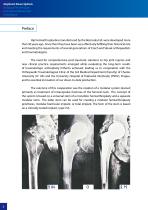
Implant Description Surgical Technique Instrumentation Set Catalogue Preface Hip hemiarthroplasties manufactured by the Beznoska Ltd. were developed more than 30 years ago. Since then they have been very effectively fulfilling their historical role and meeting the requirements of several generations of Czech and Slovak orthopaedists and traumatologists. The need for comprehensive post-traumatic solutions to hip joint injuries and new clinical practice requirements emerged while evaluating the long-term results of traumatologic arthroplasty hitherto achieved, leading us to cooperation with...
Open the catalog to page 2
Implant Description Surgical Technique Instrumentation Set Catalogue The Characteristics of the Implants The design of the original monobloc hemiarthroplasty stemmed from the material and technological possibilities of the day. Although the design has served tens of thousands with good results, it did have certain shortcomings: 1. A small lateralization of the head mid-point from the stem longitudinal axis and a rather wide angle between the stem and the neck of the prosthesis shortened the lever of the abductors. This increased pressure on the acetabular cartilage, thus reducing tonization...
Open the catalog to page 4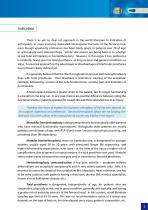
Indication There is as yet no clear-cut approach in the world literature to indication of arthroplasty in cases involving dislocated intracapsular fractures of the femoral neck, even though apparently preference has been lately given, in patients over 70 of age, to arthroplasty over osteosynthesis. Similar discussions are being held as to whether to use total arthroplasty or hemiarthroplasty. However, in this respect, too, preference is evidently being given to total prostheses, as long as local and general conditions so allow. A universal approach to the advantages or disadvantages of...
Open the catalog to page 5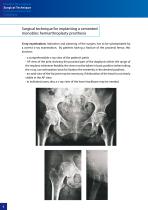
Implant Description Surgical Technique Instrumentation Set Catalogue Surgical technique for implanting a cemented monobloc hemiarthroplasty prosthesis X-ray examination: Indication and planning of the surgery has to be substantiated by a correct x-ray examination. By patients having a fracture of the proximal femur, this involves: - a comprehensible x-ray view of the patient’s pelvis - AP view of the joint showing the proximal part of the diaphysis within the range of the implant; whenever feasible, the view must be taken in basic position (when taking the x-ray, use antirotation boot for...
Open the catalog to page 6
This series of x-ray views should enable you correctly to assess the type and degree of dislocation of the fracture, the condition of the opposite hip joint (degenerative symptoms, preceding surgery), the condition and shape of the bone marrow canal where the stem will be inserted (angulation, presence of implants preventing from the stem induction, etc.), any signs of degenerative deformations in the lower backbone (spinal anesthesia, post-surgery pain). Implant indication and selection: Covered in preceding chapter. Use of antibiotics: Prophylactic administration of ATB is matter of...
Open the catalog to page 7
Implant Description Surgical Technique Instrumentation Set Catalogue Resection of the femoral neck: The level of resection is extremely important for ensuring long-term functionality of the joint. As a rule, the head mid-point of implant should be just below the top of large trochanter. A higher level of the head mid-point would increase pressure on the acetabulum – in fact, this error happens to be the most common cause of the acetabulum damage!!! Vice versa, “sinking-in” the head too far would cause insufficient tonization of soft tissues, leading to instability of the joint. In this...
Open the catalog to page 8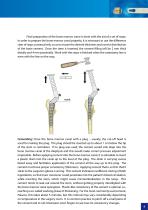
Final preparation of the bone marrow canal is done with the aid of a set of rasps. In order to prepare the bone marrow canal properly, it is necessary to use the difference sizes of rasps consecutively, so as to ensure the desired thickness and correct distribution of the bone cement. Once the stem is inserted, the cement filling will be 2 mm thick distally and 4 mm proximally. Work with the rasps is finished when the osteotomy line is even with the line on the rasp. Cementing: Close the bone marrow canal with a plug – usually, the cut-off head is used for making the plug. The plug should...
Open the catalog to page 9
Implant Description Surgical Technique Instrumentation Set Catalogue Adjusting anteversion and inserting the stem: Before inserting the stem, we have to adjust anteversion correctly, i.e., to approx. 10-15°. Excessive anteversion would put too much pressure on the front part of the acetabulum, causing it to erode too soon. Retroversion, especially if using the posterior approach, causes post-surgery instability. With the anterior approach, checking whether anteversion is adjusted correctly can be done the same ways as when performing a total replacement surgery. With the posterior approach,...
Open the catalog to page 10
Finishing the surgery: Once the cement hardens and trial fitting has been done, we check the joint for mobility and stability. Provided that everything in all right, we perform a meticulous suture of the canal – if posterior approach was applied, we reinsert the short external rotators, insert R-drains, and close the wound. Post-surgery care: Post-surgery positioning is very important. If anterior approach was used, we apply an antirotation boot into the position of moderate inward rotation; if posterior approach was used, we put into the position of moderate outward rotation. The point is...
Open the catalog to page 11
Implant Description Surgical Technique Instrumentation Set Catalogue Illustrations of the Surgical Technique Prof. MUDr. Jan Bartoníček, DrSc. Orthopedic Traumatological Clinic, 3rd LF UK and FNKV, Prague - Vinohrady Pre-surgery x-ray of dislocated intracapsular femoral neck fracture. Anterior view of the hip joint capsule. Arthrotomy with part so capsule on suspension stitches. Dislocated intracapsular femoral neck fracture. Anterolateral Watson-Jones approach. Revision of the acetabulum after head extraction.
Open the catalog to page 12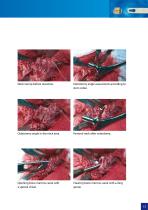
Osteotomy angle assessment according to stem collar. Femoral neck after osteotomy. Opening bone marrow canal with a special chisel. Clearing bone marrow canal with a long spoon.
Open the catalog to page 13All Beznoska catalogs and technical brochures
-
SKIN STAPLER 35W
1 Pages
-
Cementless cup – type SF
20 Pages
-
Radial Head Replacement
12 Pages
-
Humeral head resurfacing
12 Pages
-
Hip Joint Head Replacements
8 Pages
-
Cemented femoral stem - type CSC
16 Pages
-
Cerclage System
12 Pages
-
UNIQUE MANUFACTURING METHOD
1 Pages
-
Implants for Traumatology
16 Pages
-
Revision systems
32 Pages
-
Implants for primary surgery
44 Pages
-
Individual oncological implants
24 Pages























